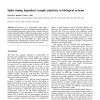1998 search results - page 117 / 400 » Basic Association Rules |
KR
2004
Springer
14 years 3 months ago
2004
Springer
In this paper, partial knowledge about the possible transitions which can take place in a dynamical environment is represented by a set of pairs of propositional formulae, with th...
BC
2005
13 years 10 months ago
2005
The hippocampus plays an important role in the course of establishing long-term memory, i.e., to make short-term memory of spatially and temporally associated input information. In...
GECCO
2000
Springer
14 years 1 months ago
2000
Springer
This paper shows how linguistic classification knowledge can be extracted from numerical data for pattern classification problems with many continuous attributes by genetic algori...
DATE
1999
IEEE
14 years 2 months ago
1999
IEEE
In this paper, a method for the automatic sizing of analog integrated circuits is presented. Basic sizing rules, representing circuit knowledge, are set up before the sizing and a...
BC
2002
13 years 10 months ago
2002
Association of a presynaptic spike with a postsynaptic spike can lead to changes in synaptic efficacy that are highly dependent on the relative timing of the preand postsynaptic sp...

